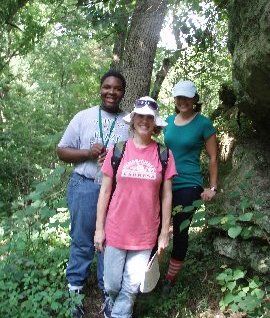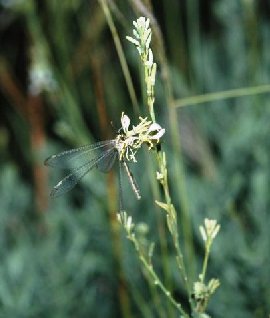Research Interests
• Systematics and evolution of Onagraceae
• Phylogeny and evolution of Epilobium
• Phylogenetics and biogeography of Ludwigia
• Climate-related phenological change and impacts on pollination systems
Web Page: MBG, Onagraceae: The Evening Primrose Family
Dr. Kyra Krakos
Research Interests
• Reproductive biology of flowering plants
• Phylogenetics and evolution of Oenothera
• Pollination biology and climate change
• Invasive species management
What impacts do changes in plant phenology have on community pollination relationships? Recently documented worldwide declines in insect pollinators, which are responsible for pollination of most wild and cultivated plants, suggest an urgent need for better understanding of pollination community dynamics in a changing world. Many recent studies document changes in plant and animal phenology and/or shifts in distribution in response to changes in climate. This project has four specific objectives: (1) determine habitat-specific changes in plant community phenology in response to climate change, (2) explore potential changes in insect floral resource use and specialization, (3) compare changes in the phenological mismatch of generalist versus specialist pollinators and their food plants, and (4) elucidate the impact of changes in pollinator behavior on plant reproductive success. We are carrying out weekly monitoring of plant phenology in multiple communities, adding to a dataset begun in 1937 at the Shaw Nature Reserve in eastern Missouri; preliminary analyses indicate both shifts in bloom time and extended duration of flowering, and therefore an increase in co-blooming species. Microclimate monitored in five different habitats with highly distinct biota, ecologies, and distributions will allow us to discern how regional climate change is experienced in specific habitats. We are now recruiting students to carry out pollination studies to explore what if any impacts these phenology changes have on community pollination relationships through time. We will compare pollinators that visit many species (generalists) with those that visit few (specialists) to see if phenology shifts impact them differentially. Students will gather pollination data for multiple plant species – observing and recording effective pollination visits, collecting plant and insect vouchers, quantifying and characterizing pollen loads on the insects, and quantifying reproductive success (fruit/seed set) in those plants – and in some cases compare those results with other historical analyses. Students will have the opportunity to publish results of their own pollination analyses, as well as to interact with multiple collaborators on broader community-wide analyses of climate-driven phenology change and community pollination ecology.
Selected Publications
• Wagner, W.L., P.C. Hoch, H. Lewis, and B. J. Grewell. 2012. Onagraceae. Pp. 925—955, in Baldwin, B.G. et al. (eds.). The Jepson Manual: Vascular Plants of California, Second Edition. Univ. California Press, Berkeley.
• Wagner, W. L., P. C. Hoch, and P. H. Raven. 2007. Revised classification of the Onagraceae. Syst. Bot. Monogr. 83: 1–240.
• Peng, C.-I., C. L. Schmidt, P. C. Hoch and P. H. Raven. 2005. Systematics and evolution of Ludwigia sect. Dantia (Onagraceae). Ann. Missouri Bot. Gard. 92: 307–359.
• Clinebell, R. R. II., A. Crowe, D. P. Gregory, and P. C. Hoch. 2004. Pollination ecology of Gaura and Calylophus (Onagraceae, tribe Onagreae) in western Texas, U. S. A. Ann. Missouri Bot. Gard. 93: 369–400.
• Krakos, K., G. Booth, J. Gardner, and M. Neipp. 2011. Nectar for plant defense: the feeding of the non-native coccinellid beetle, Curinus coeruleus, on extra-floral nectaries of Hawaiian native Hibiscus brackenridgei. Internat. J. Insect Sci. 3: 11-21.
• Krakos, K., G. Booth, and P. Bernhardt. 2010. Mechanical vs. beetle-mediated self-pollination in Gossypium tomentosum (Malvaceae), an endangered shrub. Internat. J. Insect Sci. 2: 35-49.
• Powell, K., K. Krakos, and T. Knight. 2010. Comparing the reproductive success and pollination biology of an invasive plant to its rare and common native congeners: a case study in the genus Cirsium (Asteraceae). Biol. Invas. 13: 905-917.
• Burraston, K., J. Gardner, and G. Booth. 2005. SEM evaluation of the plant-pollinator interactions between Nitidulid beetles and a native tropical Malvaceae species, Gossypium tomentosum, on Kauai. Microscopy and Microanalysis, Vol. II.
 |
 |